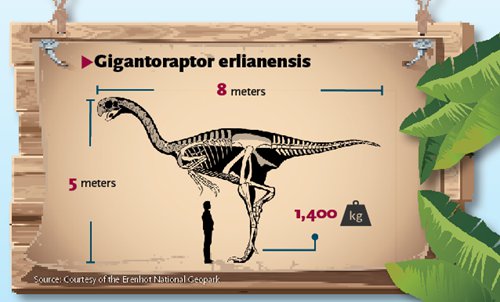

A painting of two Gigantoraptors (back) (Photo/Courtesy of the Erenhot Municipal Publicity Department)
On May 19, the China Post issued Chinese Dinosaurs, a set of themed postage stamps featuring seven dinosaurs whose fossils were first discovered in China.
One of the "terrible lizards" is Gigantoraptor erlianensis, a dinosaur that lived during the late Cretaceous Period that was discovered in Erenhot, North China's Inner Mongolia Autonomous Region.
The others six dinosaurs included in the set are Tsintaosaurus, Yangchuanosaurus, Sinosauropteryx, Microraptor, Huayangosaurus and Mamenchisaurus.
Located on the border of China and Mongolia, Erenhot serves as a gateway connecting the two countries.
However, in the field of paleontology, Erenhot is notable as being a treasure trove possessing great scientific value.
Along the Tea Road
During the Qing Dynasty (1644-1911), Erenhot served as a post on the Haalgan-Khuree Routes, a series of trade roads that connected China and the Europe that was also known as the "Tea Road."
In 1893, a Russian geologist discovered dinosaur fossils in the city, making Erenhot the first city in China where dinosaur fossils were found.
The city also boasts a number of other firsts in the paleontology field: It is the first place in Asia where dinosaur egg fossils were found; it is the first place to provide proof that dinosaurs were egg-laying animals; it is the largest area for dinosaur fossils from the Cretaceous Period; and it has the largest variety of dinosaurs anywhere in the world.
Erenhot's rich treasure trove of dinosaur fossils has attracted dozens of scientists from around the world over the years.
From 1922-28, a Central Asia expedition team from the American Museum of Natural History carried out multiple geological investigations and vertebrate fossils excavations around Dabusan Nur, a large salt lake near Erenhot.
During their investigations, scientists found dinosaur egg and bone fossils together in the same geological layers, which helped to prove that dinosaurs were oviparous.
The fossils of Ornithischia - mainly herbivorous dinosaurs whose hips were similar to modern birds - and hadrosaurs were also discovered during these expeditions.
Scientific teams from China and the Soviet Union in 1959 and teams from China and Canada in 1988 and the 1990s also carried out multiple investigations here.
In 2005, the eight-meter-long birdlike Gigantoraptor erlianensis was excavated from the east shore of Dabusan Nur by a group of Chinese scientists.
In 2007, the Chinese Academy of Sciences announced that the Gigantoraptor found in Erenhot was the largest known bird-like dinosaur fossil in the world. In a report that year, the Xinhua News Agency quoted Xu Xing, a paleontologist at the China Academy of Sciences, as saying, "without a doubt, Gigantoraptor erlianensis is the largest dinosaur with a beak to have been discovered anywhere in the world."
According to paleontologists, Gigantoraptor was about eight meters long, five meters high and weighed about 1,400 kilograms, which put it at roughly the same size as Tyrannosaurus rex. However, based on the beak, leg and other bones discovered, scientists determined that the fossil belonged to the oviraptor family, a type of dinosaur closely related to birds that were mainly small and weighed only a few kilograms.
It was for this reason that scientists named it Gigantoraptor, or "giant raptor."
Gigantoraptor had many special characteristics that set it apart from other dinosaurs. For example, its legs were thin and long, unlike most gigantic animals who had strong legs. Scientists theorize that this may indicate that Gigantoraptor erlianensis were great runners.
Cultural symbols
The city is home to the Erenhot National Geopark. According to geopark officials, probes have revealed that there are still numerous fossils waiting to be uncovered. According to estimates, fossils are spread out among an area covering some 3,000 square meters. Currently, the geopark has built a 500 square meter dinosaur fossil hall to cover some of the excavation sites.
These fossils have become a major boon for local tourism in Erenhot.
A total of 99 dinosaur sculptures can be seen decorating the grasslands around the city.
A giant sculpture of two Brachiosauruses kissing, roughly 80 meters long and 19 meters high, forms the city gate known as "Dinosaur Kiss."
"When I created these dinosaurs, I focused more on emotion rather than fact," Jin Shuangshuang, the artist behind the sculptures, told the Global Times, explaining that he took some creative license when making the sculptures.
His dinosaur sculptures can be seen everywhere on the grasslands. Some show dinosaurs grazing, while others feature dinosaur families walking together, making visitors feel like they have been transported back in time. While not 100 percent scientifically accurate, these vivid portrayals of dino life have become cultural symbols of the city.


















































